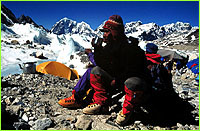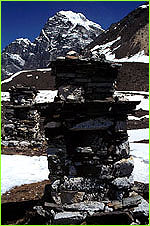
|
 |
 |
 Sherpas on Everest
Sherpas on Everestpart 2 | back to part 1 Are the Sherpas and other highland peoples physiologically different from the rest of us? Dr. Cynthia Beall of Case Western Reserve University and Physical Anthropology Advisor to the MacGillivray Freeman Films Everest IMAX/IWERKS film, postulates that there may be a genetic factor involved in Sherpa strength at altitude: "The Everest climbers must not only exert great physical effort to climb the mountain, but do so while under tremendous hypoxic stress. This stress is not something that can be mitigated in the way, for instance, that we would put on extra clothes when we are cold. We must adapt physiologically. How the Sherpas do this more effectively than others has been a puzzle to anthropologists and physiologists, and we don't really have the answer. There is evidence of a gene that allows their blood to carry more oxygen, but there are other factors that affect this, as well."  Sherpas have played quiet but critical roles in Everest
achievements. From the beginning of their involvement with
high altitude mountaineering, Sherpas have paid a
disproportionately high price in life and limb. In 1922 seven
Sherpa porters were buried under an avalanche on Everest's
North Col. In the first seventy years of Everest activity, 43
Sherpas were killed, more than a third of the total deaths in
that period. Even this year, on the south side of Everest, two
of the three evacuations from the mountain thus far—due
to serious injury—were Sherpas.
Sherpas have played quiet but critical roles in Everest
achievements. From the beginning of their involvement with
high altitude mountaineering, Sherpas have paid a
disproportionately high price in life and limb. In 1922 seven
Sherpa porters were buried under an avalanche on Everest's
North Col. In the first seventy years of Everest activity, 43
Sherpas were killed, more than a third of the total deaths in
that period. Even this year, on the south side of Everest, two
of the three evacuations from the mountain thus far—due
to serious injury—were Sherpas.
 Because of their contribution to route fixing and ferrying
supplies, they find themselves exposed to the extreme risks of
high mountain climbing more frequently than their
employers.
Because of their contribution to route fixing and ferrying
supplies, they find themselves exposed to the extreme risks of
high mountain climbing more frequently than their
employers.On our way up to Base Camp, we passed by a sacred site in the Khumbu valley, a testament to the Sherpas that have lost their lives on the surrounding peaks. Dozens of memorial chortens, each commemorating a death on the nearby mountains, line a ridge that looks out on a 360° view of snow-covered peaks. Although history has recorded their deeds as mere footnotes to greatness, it is the Sherpa contribution and effort that has been the backbone of most expeditions on Everest. Click here to hear David Breashears talk about what the Sherpas mean to him (RealAudio). Liesl Clark, NOVA Online's producer and writer, joined the expedition up to Base Camp. Audrey Salkeld of Clevedon, England is one of the world's premier Everest historians and photo researchers. Her photo editing credits include Everest: The Ultimate Book of the Ultimate Mountain and Everest: The Best Writing and Pictures from Seventy Years of Human Endeavour. Photos: (1-3) Liesl Clark. Lost on Everest | High Exposure | Climb | History & Culture | Earth, Wind, & Ice E-mail | Previous Expeditions | Resources | Site Map | Everest Home Editor's Picks | Previous Sites | Join Us/E-mail | TV/Web Schedule About NOVA | Teachers | Site Map | Shop | Jobs | Search | To print PBS Online | NOVA Online | WGBH © | Updated November 2000 |